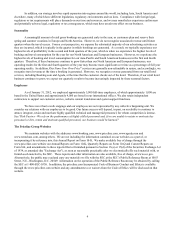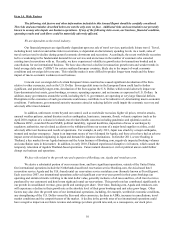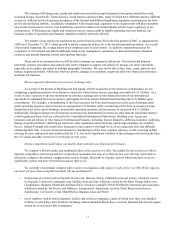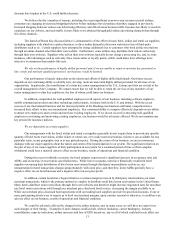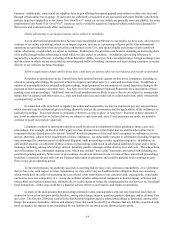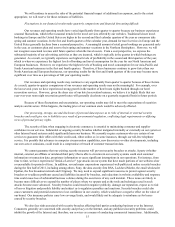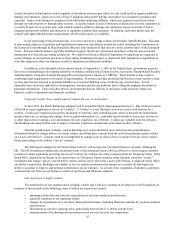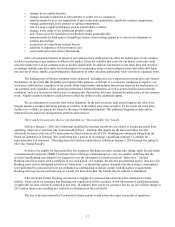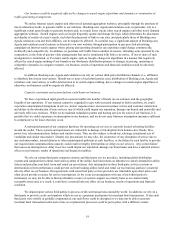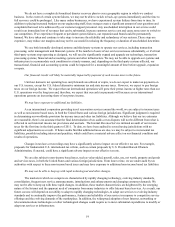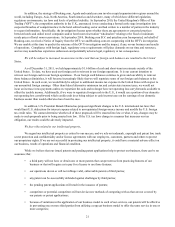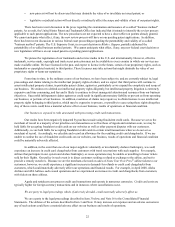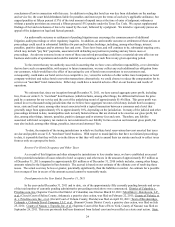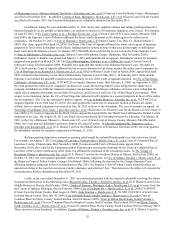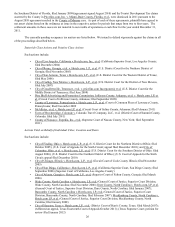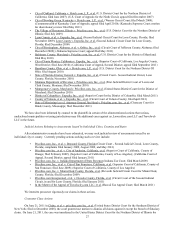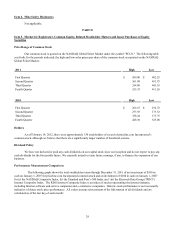Priceline 2011 Annual Report Download - page 20
Download and view the complete annual report
Please find page 20 of the 2011 Priceline annual report below. You can navigate through the pages in the report by either clicking on the pages listed below, or by using the keyword search tool below to find specific information within the annual report.19
We do not have a completely formalized disaster recovery plan in every geographic region in which we conduct
business. In the event of certain system failures, we may not be able to switch to back-up systems immediately and the time to
full recovery could be prolonged. Like many online businesses, we have experienced system failures from time to time. In
addition to placing increased burdens on our engineering staff, these outages create a significant amount of user questions and
complaints that need to be addressed by our customer support personnel. Any unscheduled interruption in our service could
result in an immediate loss of revenues that can be substantial, increase customer service cost and cause some users to switch to
our competitors. If we experience frequent or persistent system failures, our reputation and brand could be permanently
harmed. We have taken and continue to take steps to increase the reliability and redundancy of our systems. These steps are
expensive, may reduce our margins and may not be successful in reducing the frequency or duration of unscheduled downtime.
We use both internally developed systems and third-party systems to operate our services, including transaction
processing, order management and financial systems. If the number of users of our services increases substantially, or if critical
third-party systems stop operating as designed, we will need to significantly expand and upgrade our technology, transaction
processing systems, financial and accounting systems and other infrastructure. We may not be able to upgrade our systems and
infrastructure to accommodate such conditions in a timely manner, and, depending on the third-party systems affected, our
transactional, financial and accounting systems could be impacted for a meaningful amount of time before upgrade, expansion
or repair.
Our financial results will likely be materially impacted by payment of cash income taxes in the future.
Until our domestic net operating loss carryforwards are utilized or expire, we do not expect to make tax payments on
our U.S. income, except for U.S. federal alternative minimum tax and state income taxes. However, we expect to pay foreign
taxes on our foreign income. We expect that our international operations will grow their pretax income at higher rates than our
U.S. operations over the long term and, therefore, we expect that our cash tax payments will increase as our international
operations generate an increasing share of our pretax income.
We may have exposure to additional tax liabilities.
As an international corporation providing travel reservation services around the world, we are subject to income taxes
as well as non-income based taxes, in both the United States and various foreign jurisdictions. Significant judgment is required
in determining our worldwide provision for income taxes and other tax liabilities. Although we believe that our tax estimates
are reasonable, there is no assurance that the final determination of tax audits or tax disputes will not be different from what is
reflected in our historical income tax provisions and accruals. The Internal Revenue Service initiated an audit of our income
taxes for the first time in the third quarter of 2011. To date, we have been audited in several taxing jurisdictions with no
significant adjustments as a result. If future audits find that additional taxes are due, we may be subject to incremental tax
liabilities, possibly including interest and penalties, which could have a material adverse effect on our financial condition and
results of operations.
Changes in tax laws or tax rulings may have a significantly adverse impact on our effective tax rate. For example,
proposals for fundamental U.S. international tax reform, such as certain proposals by U.S. President Barack Obama's
Administration, if enacted, could have a significant adverse impact on our effective tax rate.
We are also subject to non-income based taxes, such as value-added, payroll, sales, use, net worth, property and goods
and services taxes, in both the United States and various foreign jurisdictions. From time to time, we are under audit by tax
authorities with respect to these non-income based taxes and may have exposure to additional non-income based tax liabilities.
We may not be able to keep up with rapid technological and other changes.
The markets in which we compete are characterized by rapidly changing technology, evolving industry standards,
consolidation, frequent new service announcements, introductions and enhancements and changing consumer demands. We
may not be able to keep up with these rapid changes. In addition, these market characteristics are heightened by the emerging
nature of the Internet and the apparent need of companies from many industries to offer Internet based services. As a result, our
future success will depend on our ability to adapt to rapidly changing technologies, to adapt our services to evolving industry
standards and to continually improve the performance, features and reliability of our service in response to competitive service
offerings and the evolving demands of the marketplace. In addition, the widespread adoption of new Internet, networking or
telecommunications technologies or other technological changes could require us to incur substantial expenditures to modify or
adapt our services or infrastructure.


